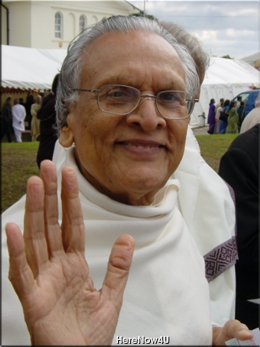
Any time you become angry with somebody, watch yourself. You will feel this: "Becoming angry I have become upset with myself. Whether the other person becomes unhappy or not, I am already unhappy now. I want to be happy but I am taking the wrong approach. Somebody did something to upset me but why am I doing more wrong to myself by becoming angry? That person did harm, but I am doing double harm to myself and the hurt increases and deepens in my consciousness."
When you are practicing Ahimsa, you try to understand why it happened. You start using loving energy to remove the cause of the hurt, that which has caused anger, rather than being angry, fighting outside, and losing connection with the cause, which made you unhappy, and angry, you free yourself.
Suppose a person speaks rudely to you. If you take that anger with you, then you will spoil your day. You have to deal with this rudeness, so you talk to the person and quietly and gently communicate with him and find out what is his point of view and what is your point of view. If this approach does not work, then you decide whether you want to keep your relation with that person or not. You think, "If this is the way he feels, then we cannot go a long way together. We are not going to help each other. So it is better to stop here." in this way, in each situation you stop to see yourself in the light of non-violence, rather than taking negative emotions.
From here we go deeper into the other four practices, supporting Ahimsa: Non-stealing, non-lying, continence and not hoarding things.
These are the subordinate practices, which promote living the life of Ahimsa. For example, if you steal somebody's things, then you are hurting somebody, and you are hurting yourself. When you steal you are always afraid, and you must hide from yourself and from the police. Also you may put yourself into a situation where violence is involved. So non-stealing is to protect the practice of non-violence.
Similarly, if you tell a lie, somebody will be hurt and you will be in a state of hide and seek which does not allow for peace. The vow is not to lie. Whatsoever you say must be true. But by making bitter and senseless statements, you might hurt someone. If you go around telling the truth about everyone's life, then you hurt people and create a quarrel. If someone is blind do we address him, "Hello, Mr. Blind," because it is true?
Now we come to continence. A person who uses his energy to chase the beauties and outer forms will be lost in that pursuit. The mind will be lost in promiscuity and the person will not have any peace. All the time he or she will remain concentrated on the outer forms. Ultimately in course of time, that sensual craving spoils one's internal peace and the person reaches a state of turmoil. So the suggestion is that you commit yourself to one person; then that person's companionship helps you to take your energy toward growth, creativity and understanding. You build a sound companionship wherein you become complementary to each other's energy, and the whole relationship blossoms in love.
So in this sense celibacy means commitment to one person and then from one person, slowly you move to your self. There are three stages according to the ancient teachings. As long as you are studying, you observe complete celibacy. You do not divert your energy anywhere but to your work, your reading, your studying, your meditation and your preparation. When you finish the studies, then you enter the marital life, sharing life with a companion, having children, communicating and understanding each other. Then when you reach the age of about fifty, both partners come to an understanding. As Mahatma Gandhi and his wife had. They became friends and decided to use their energy in the service of living beings, because their children had grown up. Then the complete celibacy started. So there are two levels: one to share the life with the partner and then ultimately to share the life with the higher self. Brahmacharya is a compound word: brahma means higher and charya means to move. The complete word means move in your higher self.
The fifth practice is non-acquisition. You make some limitations on your possessions so you do not deprive others. Tell yourself, "I can have this much and no more." Aparigraha or non-acquisition is one of the main commitments in Jainism. Parigraha means hoarding and aparigraha means not hoarding. You acquire what you need for your living and not for greed, for your house, for rainy days, but not more than that.
These are the five practices in Jainism, but the main principle is Ahimsa, and the four practices are supportive to Ahimsa, the main one. They are complementary to Reverence for Life. These guide our conduct, which help our life to grow to the higher self. In this way the whole Jain path is for freeing the self from the non-self, freeing the self from desires, expectations and poisons which we call anger, greed, jealousy and deceitfulness. Ultimately, we reach the state of enlightenment, which in this school is known as Emancipation or Moksha.
End Of Book
 Gurudev Chitrabhanu
Gurudev Chitrabhanu
